Aloo Methi is a classic Indian side dish made with tender potatoes and flavorful fenugreek leaves from Punjabi cuisine. Here I share my family’s wonderfully simple Aloo Methi Sabji recipe, including step-by-step photos (and video!) with easy to follow instructions for making this delicious veggie dish in under 25 minutes if you have prepped the fenugreek leaves earlier.
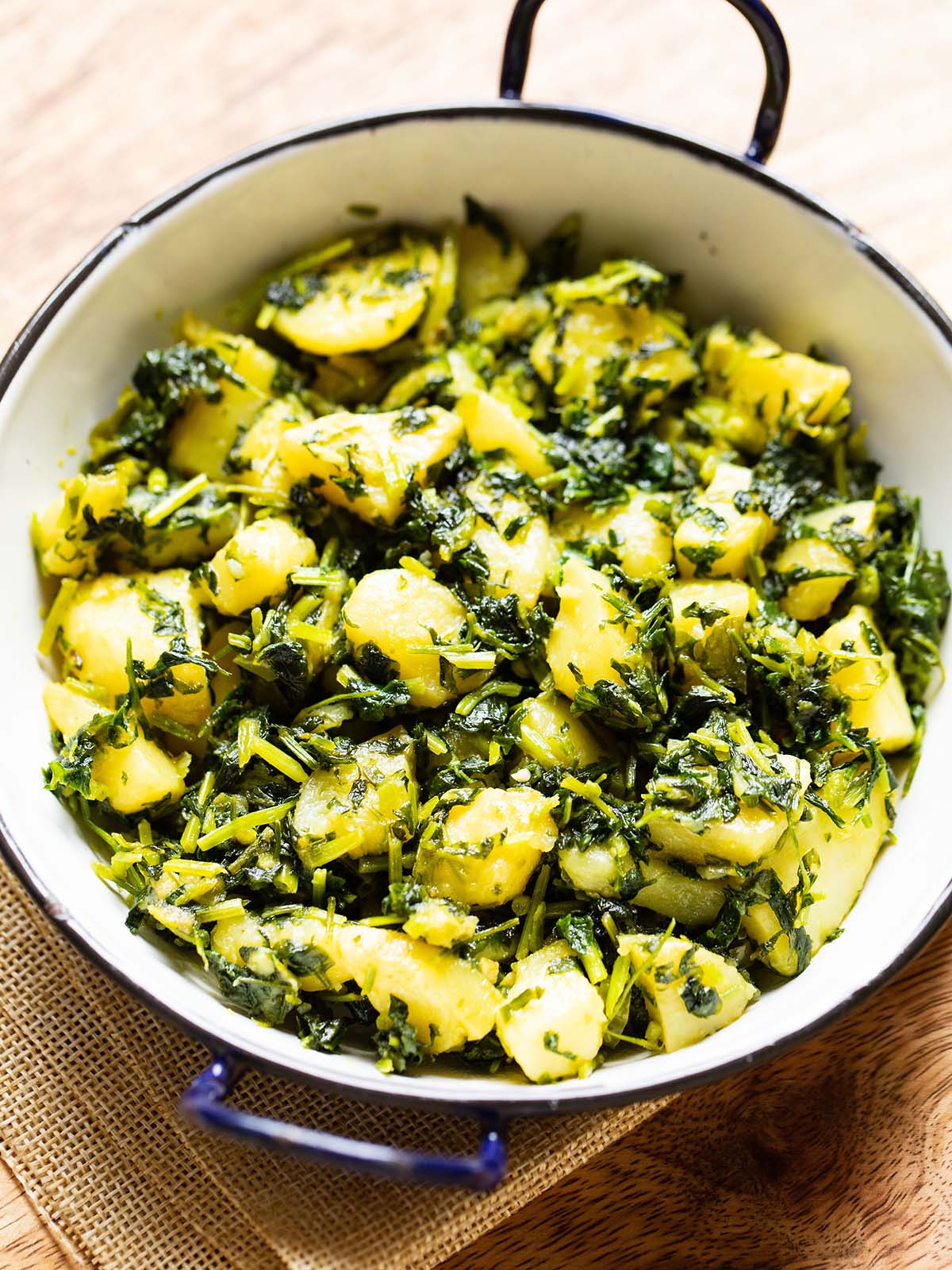
Table of Contents
About Aloo Methi
Aloo methi is a sautéed potato (aloo) side dish that features fragrant fenugreek, which is commonly known as methi leaves. We call it aloo methi sabji.
I typically make aloo methi recipe one of two ways: one is my mom’s methi aloo with garlic and onions, and the other is this more simplified Punjabi version.
My family recipe of Punjabi Aloo Methi is an authentic one and does not include a whole lot of spices or ingredients which drown the fragrant flavor of the fenugreek leaves.
Methi leaves are the star here. Don’t you agree? Why drown their awesome flavors with a multitude of ingredients!
In fact, a real Punjabi Aloo Methi is simply made with minimal spices. In this recipe, we add green chilies to give some heat with a bit of asafoetida that helps in digestion.
We do not add turmeric powder, garam masala, ginger-garlic paste, coriander powder, or cumin seeds.
As an alternative to green chilies, red chili powder can be added. In fact, adding some smashed garlic cloves gives lovely flavors and you can sub it for the asafoetida.
It’s an easy recipe that requires only a few key ingredients and is great for making either vegetarian or vegan-friendly dish. Just use your choice of either butter or any good oil!
My Aloo Methi recipe includes the flavor of mustard oil that goes terrifically with the bitterness of the fenugreek leaves.
You can opt to instead use a more mild or flavorless oil, but I urge you to give pungent mustard oil a try for a really amazing taste.
How to clean and prep Methi
Method 1
You need to take each methi stem and pluck only the leaves from it. The top tender stem shoots are fine to keep.
Gather all the methi leaves in a box or wrap in paper towels and place them in a container. Place this box or container in the crisper section of your refrigerator.
Take the required amount and rinse the leaves 3 to 4 times thoroughly before chopping them.
When the first time you soak the leaves in water, add a bit of vinegar and baking soda or salt to the bowl of water.
Method 2
After plucking the leaves, soak them in enough water in a large bowl or pot for a few minutes. Add some vinegar and baking soda or salt to the water. This gets rid of pesticides if any.
Drain all the water and soak the leaves in fresh water for a few more minutes. Swish and move the leaves with your hands, so that they are cleaned thoroughly of any soil or mud particles clinging on the stems. The mud particles need to get washed off.
Drain the water. Repeat this process once or twice or thoroughly rinse the leaves a couple of times. Finally, drain all the water.
Spread the leaves on a wired rack with a tray beneath to collect the extra water. Or place them on a kitchen towel. Let them dry naturally.
When they are dried, you can place them between kitchen paper towels and store in an airtight box in the crisper drawer of your refrigerator.
In this second method, you have to be careful as no water droplets or moisture should be on the leaves as this will make them rot.
How to reduce the bitterness of Methi
Any fenugreek leaves recipe will have their faint bitter taste which according to me is delicious. However, sometimes the bitterness can be a bit intense or too strong.
Here are a couple of tips to help mellow the bitter taste before using methi leaves to make this aloo methi:
- Place the leaves in a bowl and lightly sprinkle them with a bit of salt. Stir to coat and set aside for 15 to 20 minutes. Rinse the leaves, strain, and add to the dish
- Blanch the leaves for just a minute or so in boiling salted water. Then drain, rinse under cool water, and use.

How to make Aloo Methi
Prepare Fenugreek Leaves
1. Remove the leaves from the stems of the methi/fenugreek leaves. This takes a good amount of time, and I like to prepare a large batch at once to keep in the fridge for about a week or so and have ready as needed.
After plucking the leaves rinse them thoroughly in cool running water in a large bowl. Firstly soak the leaves in enough water for a few minutes. Add some vinegar and baking soda to the water. This gets rid of pesticides if any.
Swish and move them with your hands, so that they are cleaned thoroughly of any soil or mud clinging on the stems. This needs to get washed off.
Drain all the water and soak them in fresh water for a few more minutes. Drain the water. Repeat this process once or twice or thoroughly rinse the leaves in a colander a couple of times. Finally, drain all the water.
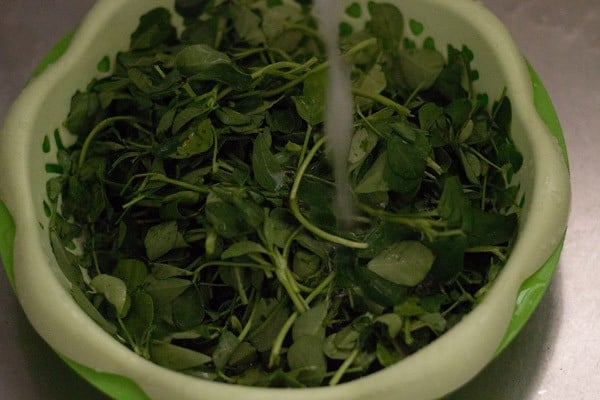
2. Use a knife or food processor to finely chop the leaves. If using a food processor be very careful that you just chop the methi and don’t accidentally turn it into a paste.
You will need 3.5 to 4 cups chopped fenugreek leaves.
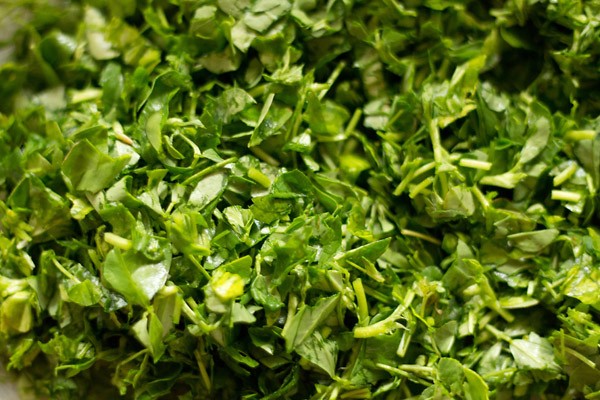
Prepare Potatoes
You can make aloo methi sabji with either regular potatoes or baby potatoes.
3. Next, rinse, peel and chop 3 to 4 medium-sized potatoes (250 grams/8.82 oz) into small cubes or squares.
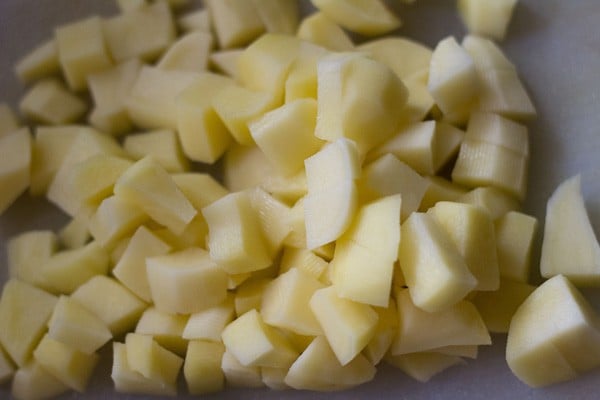
4. In a heavy and large skillet, kadai or pan, over medium-low to medium heat, heat 2 tablespoons oil or melt 2 tablespoons butter. Add the chopped potatoes.
Do use a heavy and well seasoned skillet or pan, so that the potatoes do not stick.

5. Sauté the potatoes for several minutes, until they start to look crisp and lightly golden on the outside.
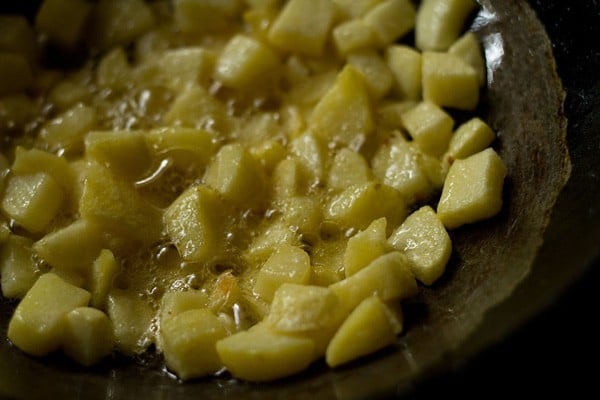
6. Then add 1 teaspoon chopped green chilies and 1 pinch of asafoetida. Alternatively, you can use ¼ to ½ a teaspoon of red chili powder in place of green chilies, and substitute asafoetida (hing) with 2 to 3 lightly smashed garlic cloves.

Make Aloo Methi
7. Now add the chopped fenugreek leaves.

8. Mix very well.

9. Add salt to taste.

10. Give a good stir, and let the aloo methi sabji continue to cook for a couple of minutes uncovered on medium-low to medium heat.

11. When the methi begins to produce some water, reduce the heat to low and cook for 5 to 6 more minutes.

12. The liquid should be totally evaporated in the dish and the fenugreek leaves will become completely wilted. Sauté for a couple more minutes to get the potatoes and methi nice and dry.
If your potatoes are not quite cooked when the liquid has dried up, add a tablespoon or so of water and continue to cook.
Later if you see any extra water in the pan, then simmer until all the water is dried up.
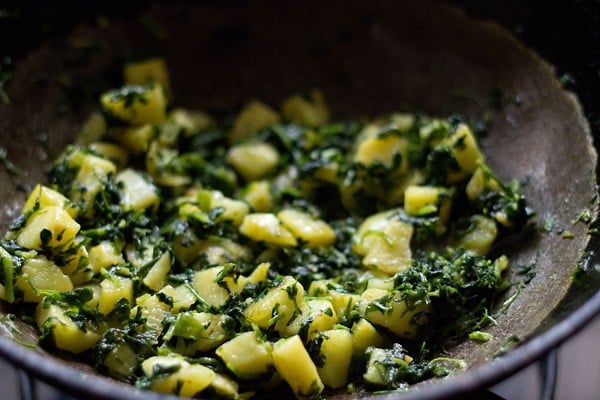
Serving Suggestions
12. Once cooked, you can either mix in a bit of butter for extra rich flavor or serve plain as-is. Enjoy aloo methi with paratha, roti or rice-dal combo.
We love to have aloo methi sabji with soft roti and a side of curd (yogurt). You could even make this dish as a side vegetable with your main course.
Aloo methi can be easily packed in lunch box with a side of some soft roti or paratha.
Storage
Usually, there won’t be any leftovers. But if there are leftovers then refrigerate in an air-tight container. Reheat by simply warming up in a small pan or skillet, sprinkling a few drops of water.

FAQs
You need to use potatoes that hold together and do not become crumbly or mealy when cooked. Waxy potatoes are a better choice: Red skinned potatoes, baby potatoes, yukon gold and new potatoes are good options.
Any neutral-flavored oil can be subbed with mustard oil. You can even use butter or ghee. Just do not use olive oil or sesame oil.
Yes, you can use kasuri methi. But the taste of aloo methi sabji with kasuri methi is not the same as with fresh fenugreek leaves. You can add about 3 to 4 tablespoons of kasuri methi.
Yes of course. You can increase the proportion of potatoes in the recipe, but then the flavors of methi will become mild. If you prefer your aloo methi this way, then you can add less potatoes. You can also add more fenugreek leaves.
Yes, this is a very healthy dish. Methi leaves are packed with vitamins and nutrients.
No, the stems of fenugreek leaves are not eaten. The methi leaves are plucked and the stem is discarded. But you can keep the top tender stem shoots.
These flavorful leaves are commonly used in Indian cuisine. Use them to make delicious dishes like Methi Chaman, Methi Paratha, Methi Pulao (Fenugreek Leaves Rice).
More Fenugreek and Potato Recipes!
Indian Curry Recipes
Potato Recipes
Methi Recipes (Fenugreek)
Vegetable Recipes
If you’ve tried this recipe, please rate it in the recipe card or leave a comment below – I’d love to hear your feedback. For more vegetarian inspiration, sign up for my email updates or follow me on Instagram, Youtube, Facebook, Pinterest or X.
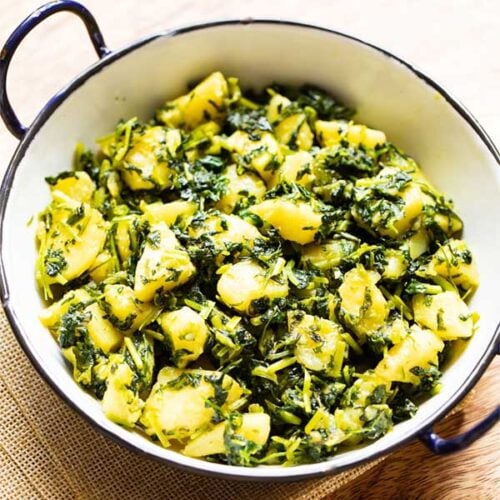
Aloo Methi Recipe
Ingredients
- 3.5 to 4 cups fenugreek leaves – chopped, tightly packed) – fresh methi leaves
- 250 grams potatoes or about 3 to 4 medium sized or 12 to 15 baby potatoes
- 1 teaspoon green chilies – chopped or 1 to 2 green chillies, or ¼ to ½ teaspoon red chili powder or cayenne pepper
- 2 tablespoons mustard oil or any neutral oil or vegetable oil
- 1 pinch asafoetida (hing)
- salt as required
Instructions
Picking and cleaning methi leaves
- Remove the leaves from the stems of the methi/fenugreek leaves. This can take a good amount of time, and I like to prepare a large batch at once to keep in the fridge for about a week or so and have ready as needed.
- After plucking the leaves rinse them thoroughly in cool running water in a large bowl. Firstly soak the leaves in enough water for a few minutes. Add some vinegar and baking soda to the water. This gets rid of pesticides if any.
- Swish and move them with your hands, so that they are cleaned thoroughly of any soil or mud clinging on the stems. This needs to get washed off. See that the leaves are clean and devoid of any muddy particles on them.
- Drain all the water and soak them in fresh water for a few more minutes. Drain the water. Repeat this process once or twice. Finally, drain all the water.
- Now chop the fenugreek leaves. You could do this with a knife or chop them in a food processor. While chopping in the food processor, make sure you do not chop it to fine or make a paste of it.
Preparing potatoes
- Rinse, peel and chop the potatoes into small cubes or squares.
- In a heavy skillet, kadai or pan, heat up the oil. Add the potatoes first.
- Saute the potatoes for some minutes on medium-low to medium heat until they start looking crisp and are lightly browned from the edges.
- Add the chopped green chilies and asafoetida. Stir. If you don't have green chilies, add about ¼ to ½ teaspoon of red chili powder or cayenne pepper.
Making aloo methi
- Now add the chopped methi (fenugreek leaves). Mix very well.
- Add salt. Give a good stir, and let the aloo methi continue to cook for a couple of minutes uncovered on medium-low to medium heat.
- When the methi begins to produce water, reduce the heat to low and cook for 5 to 6 more minutes on a low to medium-low heat.
- The liquid should be totally evaporated in the dish and the fenugreek leaves will become completely wilted.
- Sauté for a couple more minutes to get the potatoes and methi nice and dry.
- If your potatoes are not quite cooked when the liquid has dried up, add a tablespoon or so of water and continue to cook.Later, if you see any extra water in the pan, then simmer until all the water is dried up.
- Once cooked, you can either mix in a bit of butter for extra rich flavor or serve plain as-is.
Serving suggestions
- Serve aloo methi with Indian breads like paratha, roti, naan. You could even make this dish as a side vegetable with your Indian main course.
Storage
- Usually there won't be any leftovers. If there are leftovers then place in an air-tight container in the refrigerator. Reheat by simply warming up in a small pan or skillet sprinkling few drops of water.
Video
Notes
Ingredient Notes
- Potatoes: Use potatoes that hold together and do not become crumbly or mealy when cooked. Red skinned potatoes, baby potatoes, yukon gold, and new potatoes are good options. If using baby potatoes, then keep the skin on.
- Methi stems: The stems of fenugreek leaves are not eaten. The methi leaves are plucked and the stem is discarded. But you can keep the top tender stem shoots.
- Mustard oil: Any neutral-flavored oil can be subbed with mustard oil. You can even use butter or ghee. But do not use olive oil or sesame oil.
- Dried fenugreek leaves (kasuri methi) – Add about 3 to 4 tablespoons of kasuri methi in place of fresh methi leaves.
- Proportion of potatoes and fenugreek leaves: I keep a balance of both but you can increase the proportion of either according to your preferences.
How do you take the bitterness out of methi?
- Place the leaves in a bowl and lightly sprinkle them with a bit of salt. Stir to coat and set aside for 15 to 20 minutes. Rinse the leaves, strain, and add to the dish.
- Alternatively, blanch the leaves for just a minute or so in boiling salted water. Then drain, rinse under cool water, and use.
Nutrition Info (Approximate Values)
This Aloo Methi recipe from the archives first published in June 2010 has been republished and updated on January 2022.
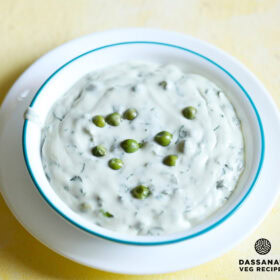

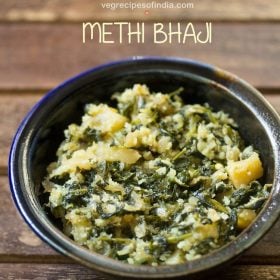



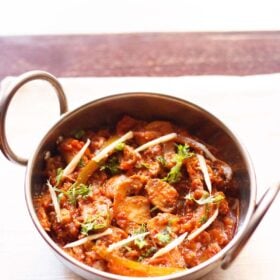
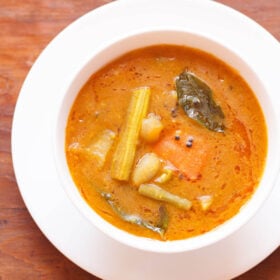








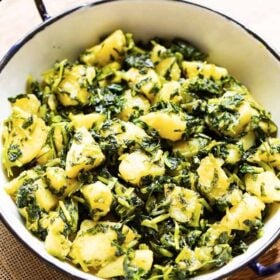
Aloo methi was one of my first impressions of Indian food, totally in love with this dish! Unfortunately these is no fresh methi where I live, so using kasoori methi instead. Not the same though…
Lovely home style recipe.
Can we use kasoori methi instead of fresh methi ! I live in Europe and it is not very very hard to find any fresh fenugreek here
you can use kasuri methi. just add 1 to 1.5 tablespoons of it. for a more bitter taste you can add more of it.
I made this tonight and couldn’t get any methi leaves fresh. I substituted celery leaves. Works really well. Hope this helps.